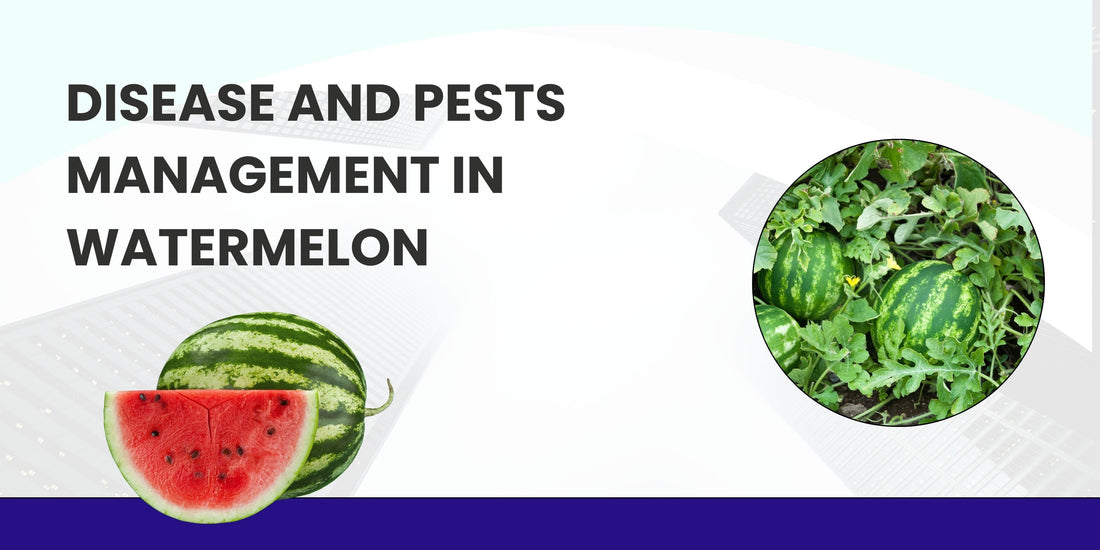
DISEASE AND PESTS MANAGEMENT IN WATERMELON
Diseases:
1. Fusarium wilt:
Watermelons are attacked by Fusarium wilt at all stages of development. Seeds may decay in the soil. Seedlings wilt collapse and die before or after emergence. Older plants wilt, wither, and die any time during the growing season. If melons do form, they are generally small and unpalatable. Wilting of runners usually progresses slowly, showing initially during the midday heat. Such plants recover at night, but after a few days they wilt permanently and die.
Management:
- Use resistant varieties, if available;
- Use disease-free seeds;
- Avoid spread of the fungus through contaminated farm implements and furrow irrigated water.
2. Anthracnose:
- Anthracnose is a very destructive disease of watermelons and other curcubits. Anthracnose attacks all above-ground parts of the plant. Watermelon can be infected at any stage of development; however, disease symptoms are first noticed as round to angular reddish brown spots on older leaves.
- Spots may later dry, turn almost black and tear out, giving a leaf a ragged appearance. Often the leaves at the center of the plant are killed first, leaving the stem and a portion of the runners bare.
Management:
- Use certified disease-free seeds;
- Treat own seeds in hot water for 20 minutes at 43° C ;
- Plant resistant varieties, if available;
- Practice crop rotation with non-cucurbits;
- Destroy volunteer cucurbits in the field.
3. Powdery mildew (Erysiphe cichoracearum and Sphaerotheca fuliginea):
Symptoms: first develop as a whitish talcum-like powdery growth on lower leaf surface. The powdery growth is composed of fungal spore mass. These areas covered by white powdery growth may enlarge and join up to cover both lower and upper leaf surfaces. Severely affected leaves dry, turn brown and become brittle. Vines can be also attacked. Secondary effects of the disease include sun-burning and premature ripening of fruits.
The powdery mildew fungi are influenced by plant age, humidity and temperature. Foliage is most susceptible 16 to 23 days after unfolding. The fungi reproduce under dry conditions. Infection increases as humidity increases, but does not occur when leaf surface is wet. Optimum temperature for infection is about 27.4º C. However, infection can take place at a temperature as high as 32º C and relative humidity as low as 46%.
Management:
- Use resistant varieties, if available
- Spray with sulphur based fungicides, which provide good control
- Destroy weeds belonging to the cucurbit family.
4. Downy mildew (Peronospora cubensis):
Symptoms on leaves appear as small, pale-yellow areas on upper leaf surface. Under humid conditions, a purplish, grey whitish growth may be seen on the underside of the yellowish spots. Affected leaves curl, shrivel and die.
Most downy mildew fungi require cool weather for reproduction and development. This is not true of the cucurbit downy mildew fungus. Optimum temperature for infection is at 16 to 22º C. It can survive when temperatures are over 37.8ºC. The most critical factor for infection is a film of moisture and / or long dew periods on leaves. Disease spread is primarily thorough by wind and rain splash. The fungus attacks only members of the cucurbit family, mostly those that are cultivated, although it can infect wild cucumber and a few other weed hosts.
Management:
- Use resistant varieties, if available;
- Leave wide spacing between plants;
- Avoid overlap cucurbit plantings;
- Copper fungicides at 0.1% can provide control.
Pests:
1. Red Pumpkin Beetle (Aulacophora foveicollis):
The pest attacks the melons at the seedling stage. They make holes in cotyledonary leaves of watermelon. As a result the seedlings in the young stage die.
Management:
Spraying Carbaryl (4 g/litre of water) or Metacid (1ml/litre of water) during the seedling stage effectively controls the pest.
2. Aphids (Aphis sp.):
Aphids damage the plants by sucking the leaf sap. in young stage, cotyledonary leaves crinkle and in severe cases the plants wither. The leaves of fully grown vines turn yellow and plant loses its vigour.
Management:
The aphids can be easily controlled by spraying Malathion (0.1 %) or Metasystox (0.1-0.2%) or Rogor (0.1-0.2%) sufficiently early before the attack becomes severe. Usually sprays against aphids and beetles can be combined.Sucking pests like Aphids can be effectively controlled by using Biopesticide “Dr.Eliminator”@250ml/litre.

3. Fruit Fly (Dacus cucurbitae and Ducus dorsalis):
The fly attack is severe, especially after summer rains when the humidity is high. Maggots of this fly causes severe damage to young developing fruits. The adult fly lays eggs in the flowers. The eggs hatch into maggots, which feed inside the fruits and causes rotting.
Management:
There is no direct control of maggots because they are inside the developing fruits. The affected fruits should be regularly pinched off and buried in a pit. Spraying of Endosulfan or Thiodan @ 6 ml/4.5 litres of water at the time of flowering partially checks the fly incidence. However, spraying should be done in the evening to prevent the repellent action to pollinating insects like bees from insecticidal sprays.
4. Mites:
The pest attains serious proportions during summer. Different stages of mite are found in colonies covered by white-silky webs on lower surface of leaves. Nymphs and adults suck cell sap and white patches appear on leaves. Affected leaves become mottled, turn brown and fall.
Management:
During egg stage and the resting stages most miticides are ineffective. At high temperatures it may be necessary to apply these at an interval of two days. Acaricides like Dicofol (0.05%) and Wettable Sulphur (0.3%) gives effective control of mites. Cutting and burning of severely infested plant parts reduces further multiplication of mites. Proper ventilation, irrigation and clean cultivation are essential to keep the pest population under control.
